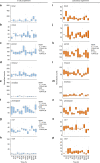Biological rhythms in the deep-sea hydrothermal mussel Bathymodiolus azoricus
- PMID: 32651383
- PMCID: PMC7351958
- DOI: 10.1038/s41467-020-17284-4
Biological rhythms in the deep-sea hydrothermal mussel Bathymodiolus azoricus
Abstract
Biological rhythms are a fundamental property of life. The deep ocean covers 66% of our planet surface and is one of the largest biomes. The deep sea has long been considered as an arrhythmic environment because sunlight is totally absent below 1,000 m depth. In the present study, we have sequenced the temporal transcriptomes of a deep-sea species, the ecosystem-structuring vent mussel Bathymodiolus azoricus. We reveal that tidal cycles predominate in the transcriptome and physiology of mussels fixed directly at hydrothermal vents at 1,688 m depth at the Mid-Atlantic Ridge, whereas daily cycles prevail in mussels sampled after laboratory acclimation. We identify B. azoricus canonical circadian clock genes, and show that oscillations observed in deep-sea mussels could be either a direct response to environmental stimulus, or be driven endogenously by one or more biological clocks. This work generates in situ insights into temporal organisation in a deep-sea organism.
Conflict of interest statement
The authors declare no competing interests.
Figures





References
-
- Kumar, V. Biological Timekeeping. (Springer, India, 2017). .
-
- Oosthuizen MK, Cooper HM, Bennett NC. Circadian rhythms of locomotor activity in solitary and social species of African mole-rats (Family: Bathyergidae) J. Biol. Rhythms. 2003;18:481–490. - PubMed
-
- van Oort BEH, et al. Circadian organization in reindeer. Nature. 2005;438:1095–1096. - PubMed
Publication types
MeSH terms
LinkOut - more resources
Full Text Sources

